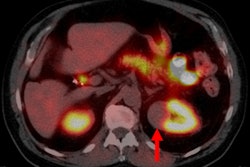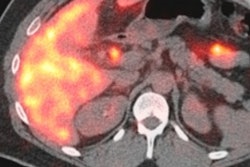The combination of SPECT/CT and white blood cells labeled with a technetium-99m (Tc-99m) radiopharmaceutical can improve the diagnosis of infectious endocarditis in difficult cases, according to a new study in the August issue of the Journal of Nuclear Medicine.
Italian researchers evaluated 131 consecutive patients with suspected infectious endocarditis using SPECT/CT and Tc-99m hexamethyl propylene amine oxime (HMPAO) white blood cells (WBCs). Patients with permanent cardiac devices were excluded because the devices may have introduced the infection (JNM, Vol. 53:8, pp. 1235-1243).
Imaging results were compared to diagnostic tests for standard infectious endocarditis: transthoracic or transesophageal echocardiography, blood cultures, and the modified Duke Endocarditis Service criteria.
Of the 131 patients, 97 (74%) showed an uptake of the imaging agent indicating the presence of infection. The Tc-99m HMPAO-WBC SPECT/CT scan was true positive in 46 (90%) of 51 patients and false negative in five (10%) of 51 cases. Sensitivity was 90%, specificity was 100%, positive predictive value was 100%, and negative predictive value was 94%. In addition, septic embolism was detected in 41% of the patients.
When the results of the Tc-99m HMPAO-WBC SPECT/CT scans were associated with a positive echocardiography result or a positive blood culture, all cases of infectious endocarditis were diagnosed, noted lead study author Dr. Paola Erba, from the Regional Center of Nuclear Medicine at University of Pisa Medical School, in a statement about the study.
The results demonstrate the added value that Tc-99m HMPAO-WBC SPECT/CT scans can provide to help physicians in their diagnosis and treatment decisions, he said.



















